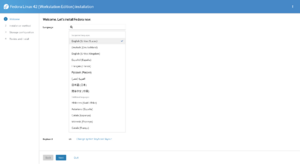Anaconda (installer) facts for kids

Anaconda's installation welcome screen for Fedora 42 Workstation
|
|
| Developer(s) | Anaconda Team |
|---|---|
| Initial release | 1999 |
| Stable release | |
| Written in | Python and C |
| Operating system | Linux |
| Available in | Multilingual |
| Type | System installer |
| License | GPLv2 (Free software) |
Anaconda is a special program that helps you install the Linux operating system on your computer. It's like a helpful guide that walks you through all the steps. This program is free to use and its code is open-source, meaning anyone can see and change it.
Many popular Linux versions use Anaconda to get set up. These include Red Hat Enterprise Linux, Fedora, CentOS, and many others. It makes installing Linux much easier for everyone.
How Anaconda Works
Anaconda is designed to be easy to use on many different computers. It has two main ways to install:
- A text mode for older or simpler computers.
- A graphical mode (GUI) with pictures and buttons, which is more common today.
This installer can work on many types of computer hardware. It can install Linux from different places. You can use a CD-ROM, a hard drive, or even download the files over the internet. This means you can install Linux no matter how your computer is set up.
Anaconda can also install Linux automatically. This is done using a special file called a kickstart file. This file tells Anaconda exactly how to set up the system. It's great for installing Linux on many computers at once. Before starting, Anaconda checks your computer. It makes sure your computer has enough power and space. If everything looks good, the installation begins.
What Powers Anaconda
Anaconda is mostly written in a computer language called Python. Some parts are also written in C. Python is known for being easy to read and write. C is used for parts that need to be very fast.
The graphical part of Anaconda uses something called GTK+ 3. This helps create the windows and buttons you see. It makes the installer look good and be easy to click through. There's also a special text-based version. This version works on very old or special computers.
Recently, Fedora 42, a version of Linux, got a new web-based look for Anaconda. This new look makes it even more modern. Other versions of Fedora will get this new look soon.
Anaconda's Hidden Tools
Anaconda has some useful tools that help with installations. These tools can also help if something goes wrong. They are like a toolbox for setting up your computer.
You can give Anaconda special instructions when it starts. These instructions change how it installs Linux. There's also a special "shell" you can use. This lets you look at what Anaconda is doing during the installation.
Anaconda also keeps important notes about the installation. These notes are stored in special files. For example:
- A file called `anaconda.log` keeps track of everything Anaconda does.
- Another file, `anaconda-ks.cfg`, saves all the choices you made during installation.
This `anaconda-ks.cfg` file is very handy. You can use it later to install Linux again. It will set up your new computer almost exactly like the old one.
Other Installers
- Calamares
- YaST
- Debian-Installer
- Ubiquity
See also
 In Spanish: Anaconda (instalador) para niños
In Spanish: Anaconda (instalador) para niños


